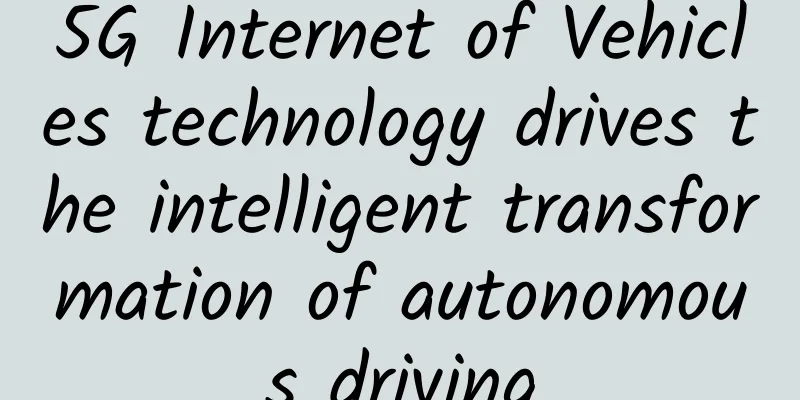5G Internet of Vehicles technology drives the intelligent transformation of autonomous driving

|
2020 is a critical period for the commercial development of 5G in China, and a new chapter has been opened in 5G ecological construction, network deployment, talent training, and industry applications. With the in-depth development of the new four modernizations in the automotive industry, in order to seize the commanding heights of the industry, traditional vehicle manufacturers, parts suppliers, and Internet giants have all made layouts in the field of intelligent connected vehicles, and the research and development and manufacturing of hardware, software, and systems related to the Internet of Vehicles have also become hot.
Based on the Internet of Vehicles, efficient communication can be achieved between vehicles, between vehicles and roads, between vehicles and people, and between vehicles and remote networks. With such powerful communication capabilities, driverless cars will become more intelligent. There is no doubt that 5G Internet of Vehicles has become an important condition for realizing vehicle-road collaboration and autonomous driving. During the autonomous driving process, the shorter the time it takes for the vehicle's sensors to monitor road conditions and command the vehicle's brain to respond, the safer the autonomous driving will be. This requires the communication network to have the characteristics of massive connections, high reliability, and low latency. In the 5G environment, the traffic control platform can issue instructions to the car in a very short time. From the perspective of overall urban transportation, we can find that intelligent networking can achieve deep integration with the city brain that mainly relies on Internet data, and its criticality and importance are self-evident. Industry insiders pointed out that in the future, intelligent networking will be deeply integrated with the city brain, and the data generated by diversified intelligent networking will better serve the city traffic brain and be deeply integrated with traffic Internet data, so as to better present the results of traffic flow analysis and OD analysis. Of course, in the trend of intelligent, connected, electrified and shared vehicles, the status of software cannot be ignored. Whether it is battery management and energy control of new energy vehicles, or functions in the field of intelligent networking such as smart cockpits and autonomous driving, they all need to rely on software to drive and operate. In the vehicle value system, the proportion of autonomous driving related software has also increased rapidly. Recently, the pilot demonstration and pilot zone project construction of Internet of Vehicles in various places has mainly focused on verifying and testing the safety and efficiency services based on LTE-V2X. As operators accelerate the construction of 5G networks, innovative Internet of Vehicles infotainment services based on 5G networks are also being verified, and applications such as panoramic synthesis, in-vehicle AR/VR video calls, and in-vehicle high-definition video surveillance are also accelerating their integration and implementation. In July this year, 3GPP announced the freezing of Rel-16 version, and completed the 5G V2X standard based on the 5G framework for the first time. If the focus of Rel-14 LTE V2X is basic safety applications, 5G V2X makes full use of the characteristics of 5G large bandwidth, low latency, and high reliability to enhance the perception ability between vehicles, and then focus on supporting autonomous driving technology. 5G-related communication technologies have undoubtedly created the necessary conditions for the implementation of autonomous driving. Specifically, in the future, driverless vehicles will need to transmit car navigation information, location information, and data from various car sensors in real time through the network to the cloud or other vehicle terminals. Each vehicle can transmit up to 1GB of data per second in order to grasp the vehicle's operating status and driving behavior in real time. The existing 4G network is difficult to meet such requirements, and 5G networks are needed to provide support. Of course, it will take some time to realize L4 and L5 autonomous driving. According to the forecast of Stanford University in the United States, L4 high-level autonomous driving will be truly realized between 2020 and 2025, and will be first applied to special vehicles such as trucks and shared taxis. For private cars, L4 autonomous driving is expected to be realized around 2030, while L5 autonomous driving will have to wait until at least after 2035. We are in an exciting and opportunity-filled technological era. The rapid integration and iteration of cutting-edge technologies such as 5G, the Internet of Things, artificial intelligence, and edge computing not only promote the practical application of basic theoretical science, but also accelerate the transformation and upgrading of the traditional automotive industry. The bright prospects of the future automotive industry are waiting for the industry insiders to jointly explore and create! |
<<: Report: By 2027, the 5G chip market will be worth $23.5 billion
>>: The “long and short” debate on WeChat video accounts
Recommend
2019 Communications Industry Statistical Bulletin: How are the three major operators doing?
The Ministry of Industry and Information Technolo...
Software: Share 9 practical computer software, worth a look
Today I will share with you 9 practical computer ...
Global fiber shortage threatens 5G and data center infrastructure
According to a report by the Financial Times (FT....
The turning point has arrived, and operators will face major changes in 2019
According to the financial report, China Telecom&...
Enterprises need to have six capabilities to achieve digital transformation
As we step into the 21st century, the wave of dig...
LTE Triangulation for Indoor Asset Tracking
What is LTE? LTE stands for long-term evolution a...
What is 5G? How is it better than 4G?
[[264309]] 5G networks will increase wireless net...
In the face of the epidemic, 5G construction should not only be accelerated, but also increased!
Since the outbreak of the novel coronavirus pneum...
How 5G standardization will impact future innovation and growth
In 2019, mobile technologies and services contrib...
After unplugging the network cable, does the original TCP connection still exist?
Hello everyone, I am Xiaolin. Today, let’s talk a...
Can the Internet of Things drive the deployment of IPv6?
IPv6 has features that IPv4 lacks, which makes it...
Is WeChat and QQ file transfer too inhumane? Here's how to fix it
For example, if the other party sends a file to y...
[Black Friday] HawkHost: 35% off on virtual hosts, 30% off on reseller hosts/cloud servers, data centers in Hong Kong/Los Angeles, etc.
HawkHost basically shares the discount once a yea...
HostDare: 20% off on CN2 GIA line in Los Angeles, starting at $28.7/year, 25% off on NVMe series QSSD, starting at $23.2/year
HostDare has launched a summer promotion. From no...
Why is 50 ohms used in RF?
[[416676]] In RF circuits, RF devices with variou...




![[6.18] UFOVPS 20% off, top up 200 yuan and get 10 yuan, US CN2/Japan CN2 GIA/Hong Kong CN2 GIA optional](/upload/images/67cabe6b63f72.webp)




